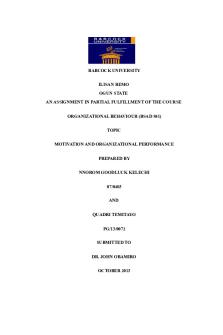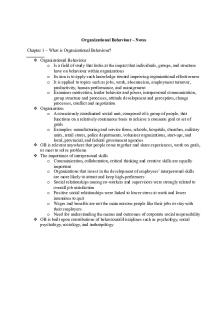Organizational behaviour by David Buchanan and Andrzej Huczynski Chapter 5 PDF

| Title | Organizational behaviour by David Buchanan and Andrzej Huczynski Chapter 5 |
|---|---|
| Course | Organisational Behaviour and Analysis |
| Institution | Brunel University London |
| Pages | 11 |
| File Size | 203.1 KB |
| File Type | |
| Total Downloads | 81 |
| Total Views | 129 |
Summary
These are entirely my notes for the MG1051 module for Weeks 1-2 for 2020/21, Year 1. These notes are based on the core reading for week 1&2. My lecturer is Euginia Xing....
Description
Organizational behaviour by David Buchanan and Andrzej Huczynski Chapter 5 Learning
Key Terms Learning The process of acquiring knowledge through experience which leads to a lasting change in behaviour. Behaviour psychology A perspective which argues that what we learn is a chain of muscle movements, which are directly observed, and thus can be studied unlike mental processes which are unobservable and invalid for study. Cognitive psychology is a perspective which argues that what we learn are mental structures, which can be studied by inferences, although not directly observable. Feedback (learning) Information about the outcomes of our behaviour. Positive reinforcement The attempt to encourage desirable behaviours by introducing positive consequences when the desired behaviour occurs. Negative reinforcement The attempt to encourage desirable behaviours by withdrawing negative consequences when the desired behaviour occurs. Punishment The attempt to discourage undesirable behaviours through the application of negative consequences, or by withholding a positive consequence, following a negative behaviour. Extinction The attempt to eliminate undesirable behaviours by attaching no consequences, positive or negative, such as indifference and silence. Pavlovian conditioning A technique for associating an established response or behaviour with a new stimulus. Skinnerian conditioning A technique for associating a response or a behaviour with its consequence. Shaping The selective reinforcement of chosen behaviours in a manner that progressively establishes a desired behaviour pattern.
Intermittent Reinforcement
A procedure in which reward is provided only occasionally following correct responses, and not for every correct response. Schedule of reinforcement The pattern and frequency of rewards contingent on the display of desirable behaviour. Cybernetic analogy An explanation of the learning process based on the components and operation of a feedback control system. Feedforward interview A method for improving employee performance by focusing on recent success and attempting to create the same conditions for the future. Intrinsic feedback Information which is internal, from the muscles and other mechanisms such as that which controls balance. Extrinsic feedback Information is from our external environment, such as the visual and aural information needed to drive a car. Concurrent feedback Information that arrives during our behaviour and which can be used to control behaviour as it unfolds. Delayed feedback Information that arrives after a task is completed, and which can be used to influence future performance. Behaviour modification A technique for encouraging desired behaviours and discouraging unwanted behaviours using operant conditioning. Socialisation The process through which an individual behaviour is influenced to conform with those seen as desirable in each social or organisational setting. Behaviour modelling Learning how to act by observing and copying the behaviour of others. Provisional selves The process of observing others, and the experiments we undertake in the way we act and interact in new organisational roles. Behavioural self-management
A technique for changing one’s own behaviour by systematically manipulating cues, cognitive processes, and contingent consequences. Learning organisation An organisational form that enables individual learning to create an innovative and creative environment. Single-loop learning The ability to use feedback to make continuous adjustments to maintain performance at a predetermined standard. Double-loop learning The ability to challenge and redefine the assumptions underlying performance standards to improve performance. Tacit knowledge Knowledge specific to the individual based on experiences, difficult to codify and communicate to others. Explicit knowledge Knowledge that is codified, clearly articulated and available to anyone. Knowledge management The conversion of individual tacit knowledge into explicit knowledge so that it can be shared with others in the organisation. RECAP 1. Explain the characteristics of the behaviourist and cognitive approaches to learning. Behaviourist approaches to learning argues that we learn chains of muscle movements, these observable movements can then be studied. However, cognitive approaches to learning argues that we learn mental structures, and we can draw inferences from these processes even though they are not directly observable. Similarly, in behaviourist theory, feedback contributes to learning by providing positive reinforcement; in cognitive theory, feedback provides information and is motivational. 2. Explain and evaluate the techniques of behaviour modification. Behaviour modification is a technique for encouraging desired behaviours and discouraging unwanted behaviours using operant conditioning. One example of behaviour modification is Pavlovian conditioning which refers to a method by which an established response (good work performance) is related to a new stimulus (supervisory encouragement). Another example is Skinnerian conditioning which refers to a method by which a behaviour (good work performance) is associated with a new consequence (bonus payment). Thirdly, positive reinforcement, negative reinforcement, punishment, and extinction condition the target by manipulating the consequences of desirable and undesirable behaviours. In conclusion, behaviour modification works well when the rewards are linked clearly to specific behaviours but does not work well when these links are not clear. It is important to note that this manipulation may not be acceptable in some cultures.
3. Explain the socialisation process and assess the practical relevance of this concept. Socialisation is the process through which an individual’s behaviour is influenced to conform with those seen as desirable in each social or organisational setting. Social learning theory argues that we learn values, beliefs, and behavioural patterns through experience, observations, and modelling. This can occur is social or organisational settings. 4. Explain and evaluate the technique of behavioural self-management. Behavioural self-management is a technique for changing one’s own behaviour by systematically manipulating cues, cognitive processes, and contingent consequences. The technique requires the individual to identify the behaviour that they wish to change, alter the situational cues that trigger that behaviour, and establish support through reinforcement for the new desired behaviour. 5. Describe the characteristics of the learning organisation. A learning organisational enables individual learning to create an innovative and creative environment. The characteristics of a learning organisation is its approach to strategy, environmental scanning, and use of information to create learning opportunities. Learning organisations instil knowledge management (a technology-based approach) to make tacit knowledge available more widely, through individual and corporate databases. 6. What part do feedback and reinforcement play in the cognitive and behaviourist approaches to learning? The behaviourist approach to learning results in reinforcement. The cognitive approaches to learning the feedback information provided is motivational. 7. Describe and illustrate the technique for organisational behaviour modification and identify the advantages and disadvantages of this technique. Organisational behaviour modification is a technique use to encourage desired behaviours, and to discourage unwanted behaviours through conditioning techniques. One technique is Pavlovian conditioning which refers to a technique in which the established response is associated with the new stimulus. Another technique used is Skinnerian conditioning which refers to a technique where the established behaviour is associated with a new consequence. Thirdly, positive reinforcements, negative reinforcements, punishment, and extinction are used as a behaviour modification technique to condition the target by manipulating the consequences of desirable and undesirable behaviours. The advantages of behaviour modification techniques are that it works best when the rewards are clearly linked to specific behaviours. However, the disadvantages are that it does not work well if the rewards are not clearly linked to specific behaviours and the manipulation of behaviour may not be acceptable in some cultures. 8. What is the difference between feedback and feedforward? With regards to performance appraisals what are the advantages and disadvantages of this approach? Feedback learning provides information based the outcomes of our behaviour, whereas feedforward learning is a technique used to improve learning performance by focusing on recent successes an attempting to create the same conditions in the future. One advantage of feedforward is that it can improve employee performance by focusing on the positives of the employee and encourage them to create the same conditions of success. The disadvantages of feedback learning are that employees may not benefit from the feedback in the long term, becoming demoralised or not seeing the purpose of the feedback at the time.
9. What are the advantages and disadvantages of the learning organisation from a management perspective, and then from an employee perspective? Why should there be any contradiction between these viewpoints? A learning organisation enables individual learning to create an innovate and creative environment. From a management perspective the advantages of a learning organisation is that it is able to adapt to changes in the environment using pattern recognition. The weakness of a learning organisation is that in unprecedent changes then the learning organisation will not be able to use pattern recognition to adapt to changes in the environment. From an employee perspective, the advantages are that innovation and creativity is encouraged. The disadvantages are that in reality organisations restrict innovation and creativity. Key Definitions Term Learning Behaviour Psychology
Cognitive Psychology
Feedback Learning Positive Reinforcement
Negative Reinforcement
Punishment
Extinction
Pavlovian Conditioning Skinnerian Conditioning Shaping
Intermittent Reinforcement
Schedule Reinforcement Cybernetic Analogy
Definition Learning refers to the process of acquiring knowledge from past experiences that lead to a relatively permanent change in behaviour. Behaviour psychology refers to a perspective which argues that the way we learn is from a chain of muscle movements, and are directly observed, unlike mental processes which are unobservable. Cognitive psychology refers to a perspective which argues that the way we learn are mental structures, and can be studied through inferences, although not directly observable. Feedback information refers to information about the outcomes of our behaviour. Positive reinforcement refers to an attempt to encourage desirable behaviours by introducing positive consequences when the desired behaviour occurs. Negative reinforcement refers to an attempt to encourage desirable behaviour by withdrawing negative consequences when the desired behaviour occurs. Punishment refers to an attempt to discourage undesirable behaviour by introducing negative consequences, or withholding positive consequences, following a negative behaviour. Extinction refers to an attempt to eliminate undesirable behaviours by attaching no consequences, positive, or negative, such as indifference and silence. Pavlovian conditioning refers to a technique for associating an established response or behaviour with a new stimulus. Skinnerian conditioning refers to a technique for associating an established response or behaviour with a consequence Shaping refers to the selective reinforcement of chosen behaviours in a manner that progressively establishes a desired behaviour pattern. Intermittent reinforcement refers to rewarding the desired behaviour only occasionally following correct responses, and not after every correct response. Schedule reinforcement refers to the pattern or frequency to which the desired behaviour is rewarded Cybernetic analogy refers to an explanation of learning processes based on the components and operations of a feedback control
Feedforward Interview
Intrinsic Feedback External Feedback
Concurrent Feedback Delayed Feedback Behaviour Modification
Socialisation Behaviour Modelling Provisional Selves
Behaviour self-management
Learning Organisation Single-loop learning Double-loop learning
Tacit knowledge Explicit Knowledge Knowledge Management
system Feedforward interview is a technique used to improve employee performance by focusing on recent successes and then aiming to recreate the same success in the future Intrinsic feedback refers to internal information, from the muscles and other mechanisms such as those that control balance. External Feedback refers to external information, from the environment such as the visual and aural information needed to drive a car. Concurrent feedback refers to information that arrives during our behaviour and which can be used to control behaviour as it unfolds. Delayed feedback refers to information that arrives after a task is completed and can be used to influence future performances. Behaviour Modification refers to a technique used to encourage desired behaviours and discourage unwanted behaviours by using operant conditioning. The process through which an individual conforms their behaviour with the desirable behaviour in a social or organisational setting. Behaviour modelling is the process of learning how to act by observing and copying others. Provisional selves refer to the process of experimenting and observing others and the way we interact in new organisational roles. Behaviour self-management refers to a technique to change one’s own behaviour by systematically manipulating cues, cognitive processes, and contingent consequences. Learning organisation refers to an organisation that enables individual learning by encouraging innovation and creativity. Single-loop learning refers to using feedback to maintain predetermined standards. Double-loop learning refers to using feedback to challenge and redefine assumptions to improve the solution and subsequent performance. Tacit knowledge is knowledge that is specific to the individual based on experiences and is difficult to explain/codify to others. Explicit knowledge refers to knowledge that is codified and is clearly articulated and readily available to anyone. Knowledge Management refers to the conversion of tacit knowledge into explicit knowledge, that is then shared throughout the organisation.
Revision Table Learning Behaviour Psychology Cognitive Psychology Feedback learning Positive Reinforcement
Negative Reinforcement Punishment Extinction Pavlovian Conditioning Skinnerian Conditioning Shaping Intermittent Reinforcement Schedule Reinforcement Cybernetic Analogy Feedforward Interview Intrinsic Feedback Extrinsic Feedback Concurrent Feedback Delayed Feedback Behaviour modification Socialisation Behaviour Modelling Provisional Selves Behaviour-self management Single-loop learning Double-loop learning Tacit Knowledge Explicit Knowledge Knowledge Management Organisational Learning Lecture Concepts Kolb’s Learning Cycle Kolb’s learning cycle shows how the internal cognitive learning process and reflection of a learner. The Cycle consists of 4 stages: Concrete experience, Reflection or Observation, Abstract Conceptualisation, and Active Experimentation. Concrete Experience Concrete experience refers to a learner being required to perform a new task or to engage in an activity that requires learning. Reflective Observation Reflective Observation refers to the learner reflecting on how they performed that task on a personal basis.
Abstract Conceptualisation Abstract conceptualisation refers to the learner questioning and hypothesising how to perform/ improve their learning based on reflections. Active Experimentation
Active experimentation refers to the application of the conceptualised ideas to future tasks.
Kolb’s Learning Cycle – Shows the internal cognitive learning process or an individual and the reflection of a learner. Kolb’s Learning Cycle 1. Concrete Experience 2. Reflective Observation 3. Abstract Conceptualisation 4. Active Experimentation
Shows the internal cognitive learning process of an individual and reflection of a learner The individual must learn a new task. The individual reflects on their personal performance. The individual hypothesises how to improve performance based on their reflective observations. The individual applies the conceptualised ideas to future tasks.
Revision Table Kolb’s Learning Cycle 1. 2. 3. 4.
Learning Organisation Learning organisation refers to an organisation that aims to improve performance and effectiveness by developing a learning environment. Learning Organisation significance Developing a learning organisation enables a company to have a better competitive edge over its competitors. This is evidenced by knowledge being as valuable a resource as raw materials so that in changing environments learning organisations can learn faster than their competitors. Learning Organisations are significant because they encourage innovation and a learning environment, which results in a more flexible and adaptable approach when the surrounding environment changes. Similarly, the production of goods and services require effective performance which requires sophisticated knowledge to meet ever-changing demand.
Learning Organisations importance of investment Organisations benefit from investing in learning because it can develop skills of employees and the sub-systems to improve overall performance. Likewise, by investing in learning there can be an improved retention in staff as they are provided with personal development career paths and are
more motivated to work for a learning organisation. Thirdly, investing in learning contributes to the adaptability of an organisation when the environment changes, by using pattern recognition and double loop learning techniques.
Learning Organisation Elements of a learning organisation Advantage of a learning organisation Benefits of investment
Learning organisation refers to an organisation that aims to improve effectiveness and performance by developing a learning organisation Learning organisations encourage innovation, creativity and through pattern recognition can easily adapt to changes in the environment. Competitive edge over competitors. Improves performance by developing employee skills, higher staff retention, increased motivation of staff, adaptability to the environment.
Revision Table Learning Organisation Elements of a learning organisation Advantage of a learning organisation Benefits of investment The Fifth Disciplines The five disciplines refer to learning processes that can be practiced by an organisation to create an effective learning organisation. Personal Mastery Personal mastery refers to developing our patience and seeing things objectively which in turn helps the individual to identify the gap between reality and our visions. This objective perspective enables the individual to practice associated activities to realise that vision. The three characteristics of personal mastery are: 1) Defining what is important to us. 2) Identifying the current reality as it is through objective viewing. 3) Identifying the gap between our vision and the reality. Thus, pursuing related activities to bridge that gap. Mental Model Mental model refers to awareness of our own biases and assumptions that influence our own actions and behaviours. Shared Vision
Shared vision refers to building a shared vision of employees and the overall goals and direction of the organisation. The shared vision can be a powerful motivator, particularly when the goal...
Similar Free PDFs

Chapter 2 ORGANIZATIONAL BEHAVIOUR
- 23 Pages
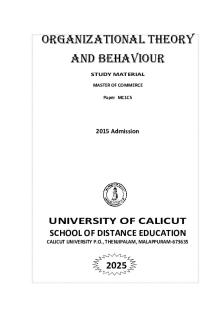
Organizational theory and behaviour
- 186 Pages
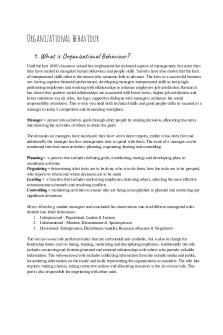
Organizational behaviour
- 67 Pages

Organizational Behaviour
- 2 Pages
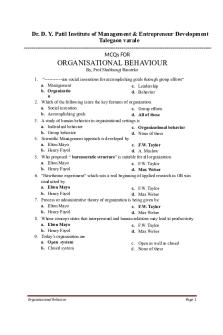
Organizational Behaviour mcqs
- 27 Pages
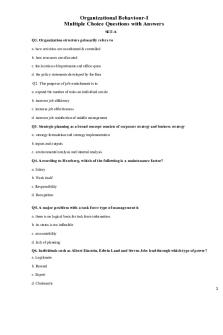
Organizational Behaviour MCQ SET
- 20 Pages
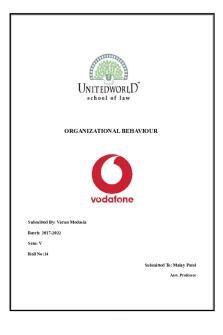
Organizational Behaviour Project
- 15 Pages
Popular Institutions
- Tinajero National High School - Annex
- Politeknik Caltex Riau
- Yokohama City University
- SGT University
- University of Al-Qadisiyah
- Divine Word College of Vigan
- Techniek College Rotterdam
- Universidade de Santiago
- Universiti Teknologi MARA Cawangan Johor Kampus Pasir Gudang
- Poltekkes Kemenkes Yogyakarta
- Baguio City National High School
- Colegio san marcos
- preparatoria uno
- Centro de Bachillerato Tecnológico Industrial y de Servicios No. 107
- Dalian Maritime University
- Quang Trung Secondary School
- Colegio Tecnológico en Informática
- Corporación Regional de Educación Superior
- Grupo CEDVA
- Dar Al Uloom University
- Centro de Estudios Preuniversitarios de la Universidad Nacional de Ingeniería
- 上智大学
- Aakash International School, Nuna Majara
- San Felipe Neri Catholic School
- Kang Chiao International School - New Taipei City
- Misamis Occidental National High School
- Institución Educativa Escuela Normal Juan Ladrilleros
- Kolehiyo ng Pantukan
- Batanes State College
- Instituto Continental
- Sekolah Menengah Kejuruan Kesehatan Kaltara (Tarakan)
- Colegio de La Inmaculada Concepcion - Cebu

